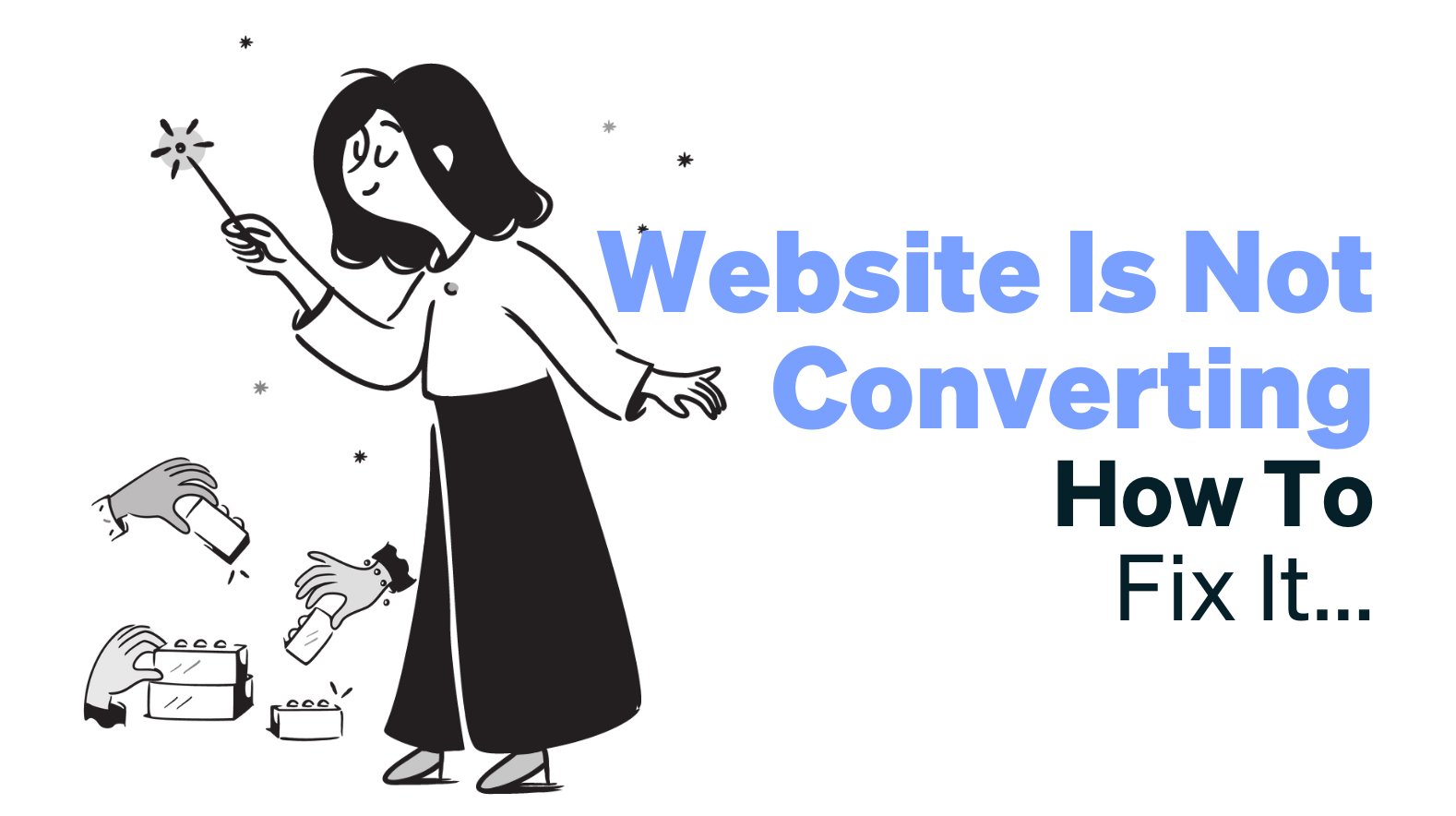
Tired of seeing traffic but no results? If your website is not converting, you’re not alone. Many businesses struggle with this same problem; a beautiful site that simply doesn’t drive action.
Traffic is coming in. Clicks are happening. Bounce rates look reasonable, and visitors stay on your pages for a while. But despite all that, your website is not converting into sign-ups, demo requests, sales, or leads.
Sound familiar?
This is one of the most common problems businesses face in today’s crowded digital space. A stunning website without conversions is like a car without fuel — nice to look at, but it won’t take you anywhere. The good news? If your website is not converting, the reasons are usually fixable and faster than you think.
Below are the 8 most common reasons why your website is not converting, plus proven ways to fix them today.
1. Messaging Isn’t Clear or Customer-Focused
When your website is not converting, unclear messaging is often the biggest culprit. Users don’t read every word — they scan for what’s relevant. You have just seconds to prove you understand their problem.
Generic headlines like “We offer innovative solutions” mean nothing to a visitor who wants to know exactly what you’ll do for them.
Fix it:
– Open with a crystal-clear value prop.
– Use “you” instead of “we”.
– Lead with the problem you solve.

Need help sharpening your message? Explore our UX design strategies for writing microcopy that nudges action and makes sure your website is not converting problems that stick around.
2. Cluttered Layouts That Confuse
A cluttered design is another reason your website is not converting. When everything screams for attention, visitors get overwhelmed and do nothing.
A single, clear hero section with one goal always outperforms a crowded screen full of distractions.
Fix it:
– Prioritize whitespace and visual focus.
– Stick to one strong hero CTA.
– Break content into easy-to-scan sections.
We did this for Beaconer — a simplified layout and focused design helped turn around their website conversion challenge. Read our landing page guide.
3. Your Website Is Too Slow
Speed is non-negotiable. A top reason your website is not converting could be painfully slow load times. Even a 2-second delay can cost you conversions — research shows each extra second reduces conversions by up to 7%.
Speed issues don’t just frustrate users—they quietly kill your conversions.
Fix it:
– Compress images and video files without losing quality.
– Minify your JavaScript and CSS.
– Run regular audits using PageSpeed Insights or tools like GTmetrix.

According to recent insights, faster websites don’t just keep users engaged—they also rank better and convert more. A faster site keeps visitors engaged and solves a major part of the website is not converting problem.
4. Weak CTAs = Weak Conversions
If your CTAs say “Submit” or “Learn More,” it’s no wonder your website is not converting. Generic CTAs don’t inspire clicks. A great CTA must be clear, benefit-focused, and action-oriented.
Fix it:
– Use action-driven phrases like “Start My Free Audit” or “Get Instant Quote.”
– Make your CTA pop with contrasting color and prime placement.
– Run A/B tests to find out what wording and design drive clicks.

Studies show that clear, benefit-focused CTAs can dramatically increase engagement and reduce decision fatigue. User testing insights suggest that even small tweaks—like changing a single verb—can shift conversion rates significantly. Stronger CTAs help ensure your website is not converting problems into a conversion win. The key? Tell users exactly what’s in it for them.
5. Lack of Trust Signals
Another reason your website is not converting could be that it doesn’t look trustworthy. Visitors won’t share their info with a site that feels shady or anonymous. Would you share your info on a site that looks sketchy or anonymous? Probably not—and your visitors feel the same. No matter how sleek your design is, if it doesn’t feel credible, people won’t convert.
Trust isn’t optional. It’s the deciding factor between bouncing and buying.
Fix it:
– Add real customer testimonials with names, faces, and results.
– Highlight well-known client logos, certifications, or media mentions.
– Use visible trust signals like SSL badges, privacy notes, and secure payment icons.
When we refreshed the nonprofit Rising Above the Storms, authentic stories and strong trust signals transformed their website is not converting issues into better donations and sign-ups.
6. Not Optimized for Mobile
Over 60% of web traffic is now mobile. If your website is not converting and it’s not mobile-friendly, that’s likely why. Poor mobile experiences frustrate visitors — they’ll leave rather than fight with bad navigation or tiny text.
If your site isn’t smooth, fast, and easy to use on a small screen, you’re quietly losing leads every day.
Fix it:
– Design mobile-first with responsive frameworks that adapt across all devices.
– Test touch targets—buttons should be easy to tap, not pinch-and-zoom.
– Use legible font sizes (at least 16px) and simplify forms for quicker completion.
Recent studies confirm that users are far less forgiving on mobile. If the experience feels even slightly broken, they leave. When your website is not converting, fixing mobile UX is one of the fastest ways to recover lost leads. Bottom line: Mobile UX isn’t a nice-to-have—it’s a conversion essential.
7. Sending Clicks to Generic Pages
Sending paid traffic or email clicks to a generic homepage? It’s no surprise your website is not converting. A homepage is broad, but conversions need focus.
Generic pages aren’t built to convert. They’re broad, unfocused, and filled with distractions. If your traffic is landing in the wrong place, your conversions won’t stand a chance.
Fix it:
– Build dedicated landing pages for every campaign, tailored to one goal.
– Remove unnecessary navigation links and visual clutter.
– Match the headline, messaging, and CTA with the original ad or email.
One focused page = one clear goal.

It’s a proven tactic for fixing a website is not converting. Our landing page guide breaks this down step by step. We cover the exact strategy in our landing page guide, packed with examples, layouts, and do’s and don’ts.
8. No Data-Driven Optimization
If you’re not tracking how users behave on your site, you’re designing in the dark. Without heatmaps, recordings, or analytics, you’re left guessing why people aren’t converting—and guessing rarely leads to results.
Fix it:
– Set up GA4 for key metrics and use session tracking tools like Hotjar or Microsoft Clarity.
– Monitor bounce rates, scroll depth, and form drop-offs to spot where users disengage.
– Run regular A/B tests on headlines, layouts, and CTAs to see what works.
Data is your best tool when your website is not converting. The more you measure, the more you learn — and the more you convert.
Wrap-Up: Ready to Fix Your Conversion Rates?
If your website is not converting, you don’t need magic — you need smart design, clear messaging, and strategies that build trust.
At Leo9 Design, we help brands fix the website is not converting challenge every day. We craft digital experiences that do more than look good — they deliver real, measurable results.
Remember: you don’t need more traffic — you need traffic that converts. If your website is not converting, it’s time to stop guessing and start improving.
Ready to fix if your website is not converting?
Get in touch with us today.
FAQS for Why Website is Not Converting-
1) Why is my website not converting?
Your website is not converting because of common issues like unclear messaging, cluttered design, slow load times, weak CTAs, lack of trust signals, poor mobile optimization, sending clicks to generic pages, or not using data to optimize.
2) Why is your content not converting?
Your content may not be converting because it’s not clear, customer-focused, or benefit-driven. If your messaging is vague and your CTAs are generic, visitors won’t know what to do next, which means no conversions.
3)Why am I not getting conversions?
You’re not getting conversions because your website has overlooked gaps in design, usability, or trust. Without clear messaging, fast performance, and focused calls-to-action, visitors lose interest and leave without taking action.
4) What to do if a website is not working?
If your website is not converting, fix the root problems: clarify your message, simplify your layout, speed up load times, strengthen CTAs, add trust signals, optimize for mobile, build dedicated landing pages, and use data to test and improve.






